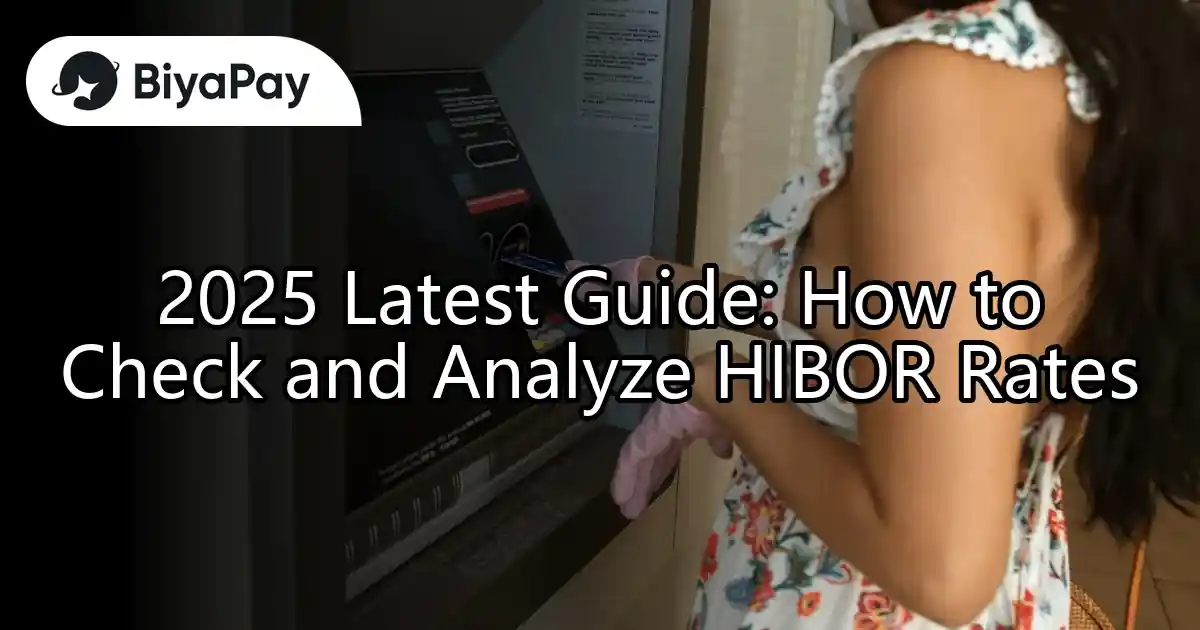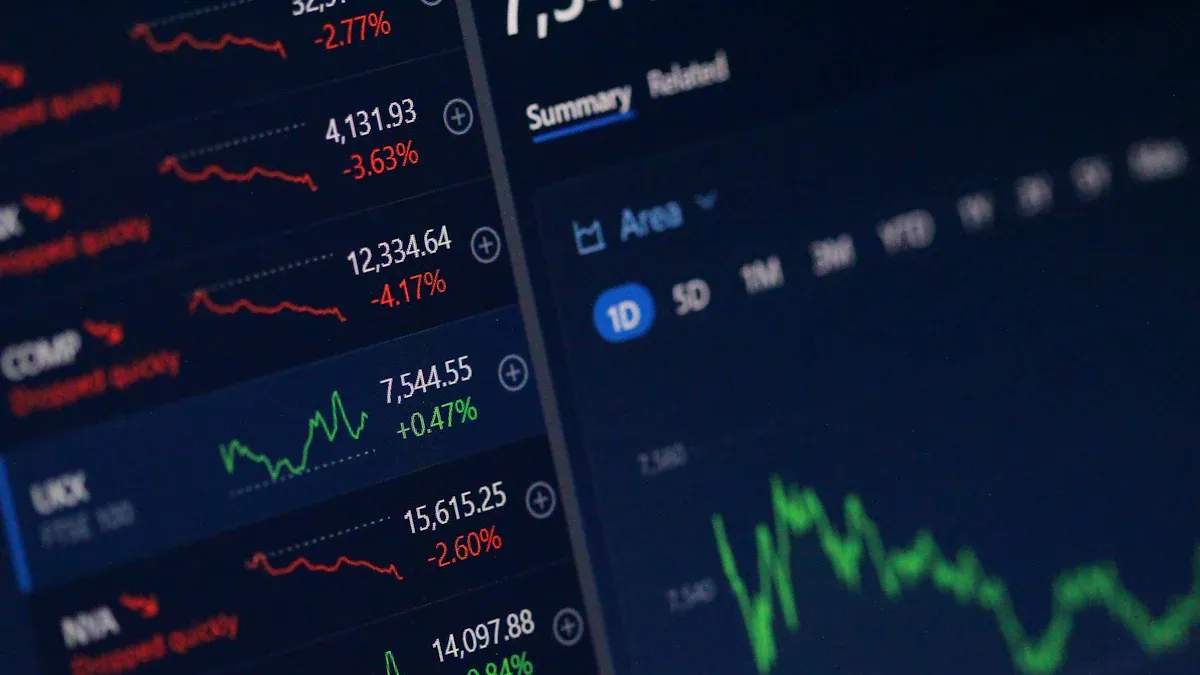- EasyCard
- Trade
- Help
- Announcement
- Academy
- SWIFT Code
- Iban Number
- Referral
- Customer Service
- Blog
- Creator
2025 Latest Guide: How to Check and Analyze HIBOR Rates

Image Source: pexels
If you want to stay updated on the latest movements of the Hong Kong Interbank Offered Rate, you can directly visit the Hong Kong Association of Banks website to check official data. With just a few simple steps, you can access daily updated rate information. Recently, the 1-month HIBOR fell to 0.545% on June 10, 2025, hitting a three-year low, reflecting a decline in funding costs, which has significant implications for your financial decisions and investment choices.
Key Highlights
- Access accurate HIBOR rates through the Hong Kong Association of Banks’ official website, updated daily at 11:15 AM, avoiding reliance on unofficial sources.
- When checking HIBOR, compare data across different dates and tenors, and note market liquidity and policy changes to improve analysis accuracy.
- Understand the significance of different HIBOR tenors, particularly the 1-month HIBOR, as it directly impacts mortgage rates and borrowing costs.
- HIBOR rate fluctuations affect mortgage repayment pressures; when choosing between HIBOR-based (H-plan) or Prime-based (P-plan) mortgages, make informed decisions based on your risk tolerance and rate trends.
- Regularly record and analyze HIBOR data to grasp market trends, flexibly adjust financial strategies, and reduce financial risks.
Hong Kong Interbank Offered Rate Inquiry

Image Source: unsplash
Official Channels
If you want to check the Hong Kong Interbank Offered Rate, you should prioritize official channels. The Hong Kong Association of Banks is the sole authority responsible for publishing HIBOR data daily. You can directly visit the Hong Kong Association of Banks’ official website, where the latest rates are updated every morning at 11:15 AM (Hong Kong time). Common tenors include overnight, 1-week, 1-month, 3-month, 6-month, and 12-month. These rates are provided by multiple Hong Kong banks, calculated uniformly, and published. Besides the Hong Kong Association of Banks, you can also refer to the official websites of major Hong Kong banks, such as HSBC, Bank of China (Hong Kong), and Hang Seng Bank. These websites synchronize HIBOR data, making it convenient for you to compare and verify.
Tip: You should avoid relying on unofficial websites or social media for HIBOR information, as these sources may be unverified and prone to errors.
Inquiry Steps
You can follow these steps to check the Hong Kong Interbank Offered Rate to ensure accurate data:
- Visit the homepage of the Hong Kong Association of Banks’ official website.
- Click on the “Market Information” or “Interest Rate Information” section.
- Locate the “Hong Kong Interbank Offered Rate” page and select the date you want to check.
- Review the HIBOR values for different tenors (e.g., 1-month, 3-month, 6-month).
- Establish a comparison benchmark, such as comparing the current day’s data with the past week or month to observe trends.
- Identify influencing factors, such as recent large-scale fund flows, festive holidays, or policy changes, which can affect HIBOR levels.
- Check for data anomalies, such as extreme high or low values, and cross-verify with other bank websites if necessary.
- Select appropriate metrics for analysis; for example, if you’re concerned about mortgage rates, focus on the 1-month HIBOR.
You can use a table to record daily data for future analysis. For example:
| Date | 1-Month HIBOR (%) | 3-Month HIBOR (%) | 6-Month HIBOR (%) |
|---|---|---|---|
| 2025-06-10 | 0.545 | 0.670 | 0.800 |
| 2025-06-09 | 0.560 | 0.685 | 0.810 |
Common Mistakes
When checking the Hong Kong Interbank Offered Rate, you may encounter these common errors:
- Only looking at a single day’s data, ignoring comparisons with past data, leading to inaccurate judgments.
- Overlooking external factors, such as policy adjustments or market volatility, resulting in inaccurate analysis.
- Using unverified data sources, increasing the risk of errors.
- Neglecting data cleaning, such as failing to exclude duplicate or anomalous values, affecting analysis quality.
- Omitting dual verification, not cross-checking data from different sources.
It’s recommended that you record data after each inquiry and review it periodically to improve analysis accuracy and reduce misjudgments.
Data Interpretation
Tenor Differences
When checking the Hong Kong Interbank Offered Rate, you’ll notice multiple tenors. The most common include overnight, 1-week, 1-month, 3-month, 6-month, and 12-month. Each tenor represents the duration of interbank lending.
- Overnight HIBOR: Banks borrow today and repay tomorrow. This rate reflects immediate market liquidity tightness.
- 1-Week HIBOR: Banks lend for one week. This rate is used for short-term fund allocation.
- 1-Month HIBOR: Banks lend for one month. This rate is most commonly used for mortgage calculations, as most HIBOR-based mortgages (H-plan) are based on 1-month HIBOR.
- 3-Month, 6-Month, 12-Month HIBOR: These tenors are often used for corporate financing or large-scale fund movements. You can focus on different tenors based on your needs.
Tip: If you’re considering applying for a mortgage, you should pay special attention to changes in the 1-month HIBOR, as it directly affects your mortgage interest.
Value Significance
Each HIBOR value represents the annualized interest rate for interbank lending over a specific tenor. For example, a 1-month HIBOR of 0.545% means banks lend or borrow funds for one month at an annualized cost of 0.545%. When you see HIBOR rising, it indicates tight interbank liquidity and higher borrowing costs. Conversely, a falling HIBOR suggests abundant liquidity and lower borrowing costs.
The Hong Kong Monetary Authority regulates banking system liquidity through Exchange Fund Bills and Notes. If the banking system balance decreases, banks need to borrow from each other, pushing HIBOR up. You can monitor the HKMA’s banking system balance and monetary policy operation data to understand HIBOR trends.
Column Descriptions
When checking HIBOR data, you’ll typically see the following columns:
| Column Name | Description |
|---|---|
| Date | The date HIBOR is published |
| Tenor | The lending duration (e.g., 1-month, 3-month) |
| HIBOR Rate (%) | The annualized interest rate for the tenor |
| High/Low Value | The highest or lowest rate quoted by banks that day |
| Average Value | The average of quotes from multiple banks |
You should focus on the “HIBOR Rate” column, as it’s the most commonly referenced data. You can also compare rates across tenors to analyze market liquidity. If you notice significant HIBOR fluctuations on a specific day, you can review HKMA liquidity data to identify the cause.
Reminder: You can record daily HIBOR data in a table; long-term observation helps you grasp market trends and make wiser financial decisions.
Trend Analysis

Image Source: pexels
Influencing Factors
To understand HIBOR trends, you must first grasp the key factors affecting it. HIBOR is influenced by fund flows, exchange rate fluctuations, and market supply and demand.
- The CNY/USD exchange rate middle price fell by over 100 basis points for two consecutive days, indicating that exchange rate fluctuations directly impact HIBOR.
- Interbank repo rates slightly declined, and the central bank’s reverse repo operations led to slight net fund withdrawals, reflecting fund flow impacts on HIBOR.
- The offshore CNY HIBOR overnight rate rose 153 basis points to a one-month high, showing significant changes in offshore funding costs.
- USDCNH swap market long-end points slightly dropped, indicating exchange rate and liquidity factors affecting HIBOR.
- U.S. Federal Reserve policies and U.S. Treasury yield changes impact the U.S.-China interest rate differential, further affecting CNY exchange rates and HIBOR.
You can observe that when liquidity is ample, HIBOR typically falls. Conversely, during tight liquidity or exchange rate volatility, HIBOR rises.
Recent Trends
Over the past year, HIBOR trends have shown significant volatility. The 1-month and 3-month HIBOR once rose to about 2.27%, hitting a decade-high. During this period, USD/HKD exchange rate volatility intensified, and fund flows shifted. The U.S. Federal Reserve’s multiple rate adjustments increased Hong Kong’s funding costs. You can see that when the U.S. raises rates, Hong Kong’s interbank rates follow suit. Recently, HIBOR fell to 0.545%, reflecting lower funding costs and improved market liquidity.
Rate Impact
HIBOR fluctuations directly affect your mortgage and loan costs. When 1-month HIBOR rose to 2.27%, several Hong Kong banks raised HIBOR-based mortgage rates. Currently, mortgage rates range from about 2.25% to 2.35%, with an upward trend. Experts predict that if HIBOR continues to rise, mortgage rates may increase by 0.5% within the year. You should closely monitor HIBOR trends, choose suitable loan products, reduce repayment pressure, and improve financial planning quality.
H-Plan vs. P-Plan Comparison
H-Plan Features
When choosing a HIBOR-based mortgage (H-plan), you’ll notice these distinct features:
- Rates are based on the Hong Kong Interbank Offered Rate, calculated as “H + x%.”
- Rates fluctuate quickly, influenced by market liquidity and HIBOR.
- Banks set a cap rate (e.g., 2.5%), so when HIBOR surges, rates won’t rise indefinitely, protecting your mortgage burden.
- The 1-month HIBOR recently hit about 2.27%, but current H-plan actual rates are around 2.25% to 2.35%, still lower than the 20-year average of about 3.5%.
- Banks’ rate hikes are moderate, with H-plan rates expected to stay below 2.75% by year-end, showing flexibility and cost advantages.
Tip: When market liquidity is ample, H-plan rates are typically lower, helping you reduce mortgage pressure.
P-Plan Features
When choosing a Prime-based mortgage (P-plan), you’ll see these features:
- Rates are based on the Prime Rate, calculated as “P – x%.”
- Rate changes are slower, mainly influenced by U.S. rate policies, less affected by local liquidity fluctuations.
- There is no cap rate, so when the Prime Rate rises, your repayment pressure increases accordingly.
- Rates are generally higher than H-plan, less competitive when HIBOR is low.
- Suitable for those seeking stable repayments, as rate fluctuations are smaller.
| Comparison Item | H-Plan (HIBOR Mortgage) | P-Plan (Prime Rate Mortgage) |
|---|---|---|
| Rate Basis | Hong Kong Interbank Offered Rate | Prime Rate |
| Rate Calculation | H + x% | P – x% |
| Rate Volatility | High | Low |
| Cap Rate | Yes | No |
| Suitable For | Seeking low costs and flexibility | Seeking stable repayments |
Selection Tips
When choosing between H-plan and P-plan, you can follow these suggestions:
- If you’re willing to tolerate rate fluctuations and want to benefit from low HIBOR rates, the H-plan is more suitable.
- If you value repayment stability and don’t want significant rate changes, the P-plan is more suitable.
- When the market expects HIBOR to stay below the Prime Rate, the H-plan is usually more cost-effective.
- When HIBOR is trending upward, or you’re concerned about sharp rate hikes, the P-plan’s stability offers more security.
- You should regularly monitor HIBOR and Prime Rate trends, consult bank professionals, and flexibly adjust your mortgage plan.
Note: Regardless of the mortgage product chosen, you must assess your repayment capacity to avoid financial pressure from rate changes.
You can follow the steps outlined in this article to check and analyze the Hong Kong Interbank Offered Rate. It’s recommended to regularly visit official websites, record daily data, and compare changes over time. You should flexibly use this information to make informed financial decisions.
Tip: Markets change rapidly, so stay updated with the latest news and adjust your financial strategy early.
FAQ
What time does HIBOR data update daily?
You can check the latest HIBOR data on the Hong Kong Association of Banks website every morning at 11:15 AM (Hong Kong time). This is the official publication time, ensuring the most accurate data.
Which loans are affected by HIBOR rates?
When you apply for mortgages, corporate loans, or short-term financing from Hong Kong banks, they reference HIBOR rates to calculate interest. H-plan products are most affected.
Where can I check HIBOR rates?
You can check HIBOR on the Hong Kong Association of Banks, HSBC, Bank of China (Hong Kong), and Hang Seng Bank official websites. These sites synchronize data for easy comparison.
Is HIBOR related to the USD exchange rate?
HIBOR is related to the USD exchange rate. Hong Kong’s linked exchange rate system means USD rate changes impact HIBOR. You should also monitor USD trends.
Is checking HIBOR data free?
Checking HIBOR data is completely free. The Hong Kong Association of Banks and major bank websites publicly provide daily updated data at no cost.
Tracking HIBOR trends helps optimize mortgage and investment decisions, minimizing costs. BiyaPay offers a single platform for trading U.S. and Hong Kong stocks without needing overseas accounts—start now at BiyaPay! Its cross-border remittances, with fees as low as 0.5%, support USD/HKD conversions (1 USD ≈ 7.8 HKD) across 190+ countries, ensuring cost clarity.
Monitor HIBOR and market trends with its economic calendar for precise decisions. The 5.48% annualized yield wealth product offers flexible withdrawals. Regulated internationally, it guarantees secure transactions. Visit BiyaPay today to enhance your financial strategy!
*This article is provided for general information purposes and does not constitute legal, tax or other professional advice from BiyaPay or its subsidiaries and its affiliates, and it is not intended as a substitute for obtaining advice from a financial advisor or any other professional.
We make no representations, warranties or warranties, express or implied, as to the accuracy, completeness or timeliness of the contents of this publication.




Contact Us
Company and Team
BiyaPay Products
Customer Services
is a broker-dealer registered with the U.S. Securities and Exchange Commission (SEC) (No.: 802-127417), member of the Financial Industry Regulatory Authority (FINRA) (CRD: 325027), member of the Securities Investor Protection Corporation (SIPC), and regulated by FINRA and SEC.
registered with the US Financial Crimes Enforcement Network (FinCEN), as a Money Services Business (MSB), registration number: 31000218637349, and regulated by FinCEN.
registered as Financial Service Provider (FSP number: FSP1007221) in New Zealand, and is a member of the Financial Dispute Resolution Scheme, a New Zealand independent dispute resolution service provider.



















